#Concrete Mixture Manufacturer
Explore tagged Tumblr posts
Note
Could you please do 2004 Tord x reader, pls? He's my comfort character x(
(btw, pls make him as an adult if ur comfy with that! The TeenTord headcanon makes me uncomfortable x(
(not forced!)
Hello why of course!! I’m gonna be completely honest, last I watched Eddsworld was back in 2014?? So my interpretation might not be the best 🙏🙏 either way I hope you enjoy!!!

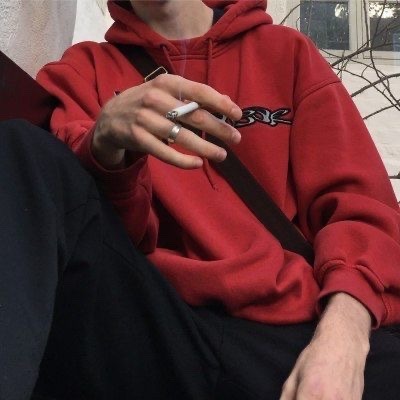

-ˋˏ✄┈┈┈┈┈┈┈┈┈┈┈┈┈┈┈┈┈┈┈┈┈┈┈┈
Pairing : 2004Tord x Reader
CW : none
Wc : 639 (wow so short)
A/N : I actually quite enjoyed this one? Im writing this at night and I didn’t have much of an idea of what else to do/ where to take it, but lowkey I can see it possibly becoming an actual story rather than a one shot. Who knows, maybe if I’m feeling inspired I’ll make it into a series
Sypnosis : You’re a mechanic working late one night when someone bursts into your workshop
-ˋˏ✄┈┈┈┈┈┈┈┈┈┈┈┈┈┈┈┈┈┈┈┈┈┈┈┈
The fluorescent lights flickered overhead, casting long shadows across the cluttered garage. It was well past midnight, one of those rare moments when the world seemed to pause, allowing you a precious slice of personal time. Your own projects—the ones that never made it to the top of the priority list—were finally getting some attention.
Being a mechanic wasn't just a job; it was a calling. Each day brought a wild mixture of characters: stubborn old men who looked at you with skeptical eyes, convinced that youth equated to incompetence; entitled customers who argued over every dollar; self-proclaimed experts who believed YouTube tutorials made them equivalent to professional technicians. You'd seen it all—or so you thought.
The sudden crash of the workshop door made you jump, your wrench clattering against the concrete floor. A lanky figure burst in, light brown hair slightly disheveled, eyes wild with an intensity that immediately set your internal alarms ringing. Your gaze shifted towards the window, the LED sign with the words “Open” was shut off.. there was no way he actually thought the shop was open.
Before you even had the chance to protest, to tell him that right now you weren’t under working hours, blueprints exploded across your workspace like a paper hurricane, accompanied by several heavy metal boxes that looked like they'd been "borrowed" from somewhere decidedly official. Immediately, your eyebrows furrowed in confusion, who the hell was this lunatic?
You didn’t have much time to question his theatrics as he soon began to explain his plan. Something about a robot.. approximately 10 meters tall? Looking down at the prints on your desk you weren’t able to tell if this was just some geeky fascination or something that you should genuinely be worried about. Regardless, it was something way out of your budget and league. Despite your interest and knowledge on cars, you weren’t so sure it applied to.. this..
"Look man, I dunno…" you started, your voice wavering between professional skepticism and genuine confusion. "I'm a mechanic, not a manufacturer. A twenty- thirty.. something foot robot? That's way beyond the standard automotive repair."
The stranger—dressed in a vibrant red hoodie that seemed almost too casual for the plans now scattered before you—let out a low chuckle. It was the kind of laugh that suggested he knew exactly how ridiculous this all seemed, and yet, didn't seem to care one bit.
"Not asking for mass production," he said, his accent carrying a hint of something Nordic—Norwegian, maybe? "Just one. Perfect prototype. Think of it as... a special order." His hands remained casually stuffed in his hoodie pockets, but there was nothing casual about the calculation behind his eyes.
The blueprints were meticulously detailed. Intricate mechanical designs intertwined with what looked like weaponry specifications. It was.. almost scary, how someone as simple as he looked was able to acquire such things, ones of such magnitude to say the least. This wasn't just a robot; this was something more. Something potentially dangerous.
"Split the profits," he continued, watching you carefully. "Fifty-fifty. All I need is your technical expertise and this workspace for a few weeks."
Something told you this was more than a simple business proposition. The boxes of materials, the precise blueprints, the way he'd so easily found his way into a private workshop, everything screamed of a deeper, more complex story.
And yet, a part of you was intrigued. Curiosity had always been your weakness, and this stranger had just presented a puzzle too compelling to dismiss.
"Who are you?" you found yourself asking, knowing the answer would likely raise more questions than it would resolve.
The smile that crossed his face was equal parts charming and dangerous—the smile of someone who knew exactly how this conversation would end, even if you didn't.
“My name is Tord, What about you, Stranger?”

#eddsworld#eddsworld tord#ew tord#tord x oc#ew fandom#eddsworld fanfic#writing#fanfiction#cc x reader#cc x oc#fanfic#Bogwaterparasite#bogwaterparasite fanfic
20 notes
·
View notes
Text
This story from Anthropocene Magazine tells us how some of the obscure research projects being conducted in labs around the world can produce some boring but environmentally stunning outcomes that can be beneficial to all of us. So be careful the next time you think "nerds." Excerpt:
A common mineral present just beneath the Earth’s crust could help to negate the carbon footprint of concrete, researchers report in the journal Royal Society Open Science. The study details a way to turn the mineral olivine, which also forms the green gemstone peridot, into an alternative for cement and other construction materials. The research team has launched a startup to commercialize their patented process.
Concrete, the most widely used material in the world, is a mix of cement, water, gravel and sand. The production of cement and concrete results in about 8 percent of the world’s carbon dioxide emissions.
Most of these emissions are generated when limestone is heated at high temperatures to produce powdery cement. The emissions come from burning fossil fuels for heat, but also from the chemical reaction itself.
Some manufacturers are reducing concrete’s emissions by replacing part of the cement with waste material such as fly ash and slag or adding other recycled materials. Studies have shown that this replacement does not reduce the strength of concrete.
Civil and environmental engineers at Imperial College London turned to olivine, a magnesium silicate mineral that is found in the rocks in the Earth’s upper mantle. The mineral naturally reacts with carbon dioxide from the air and turns into magnesium carbonate. But this process works at a very slow geological timescale.
The team wanted to see if they could speed up this carbonate-forming process. They crushed olivine samples and mixed them into sulfuric acid. This separated the silica from the olivine and created magnesium sulfate. When they bubbled carbon dioxide gas through the mixture, it reacted with the sulfate to produce magnesium carbonate, resulting in the sequestration of carbon dioxide.
The silica can be used as a cement substitute in concrete to add strength. And the magnesium carbonate can be used as a binder or filler in other low-carbon construction products such as bricks, blocks and board, the team writes in the paper.
Replacing 35 percent of regular Portland cement in concrete with the silica would give carbon-neutral cement, the researchers write. Replacing more than that could would make concrete carbon negative.
Further, they add that the olivine processing is not energy intensive and could be done electrically using renewable energy.
6 notes
·
View notes
Text
How to Choose the Right Grout for Mosaic Floor Tiles

Mosaic floor tiles are a stunning and timeless choice for adding visual interest and character to any space. However, the grout you choose can make or break the overall aesthetic and longevity of your mosaic tiled floor. Grout not only fills the spaces between the tiles but also plays a crucial role in protecting the tiles from moisture, dirt, and wear.
In this article, we'll guide you through the process of selecting the right grout for your mosaic floor tiles, ensuring a beautiful and long-lasting installation.
1. Understanding Grout Types
Before diving into the selection process, it's essential to understand the different types of grout available on the market. The two main categories are cementitious grout and epoxy grout.
Cementitious Grout: This traditional grout is made from a mixture of cement, sand, and water. It's widely available, affordable, and suitable for most residential applications. However, it's prone to cracking, shrinking, and discoloration over time.
Epoxy Grout: As the name suggests, epoxy grout is a resin-based product that offers superior durability, stain resistance, and color consistency. It's more expensive than cementitious grout but is highly recommended for high-traffic areas, wet environments, and applications where a seamless, uniform appearance is desired.
2. Considering Grout Color
The color of the grout can greatly impact the overall appearance of your mosaic floor tiles. When selecting a grout color, consider the following factors:
Tile Color: Choose a grout color that complements or contrasts with the tiles, depending on your desired aesthetic. Lighter grout colors can make the tiles appear more prominent, while darker shades can create a smoother, more uniform look.
Space Size: In smaller spaces, lighter grout colors can help create the illusion of a larger area, while darker shades may make the space feel cramped.
Maintenance: Lighter grout colors tend to show dirt and stains more easily, requiring more frequent cleaning. Darker grout colors can better hide imperfections but may also highlight uneven tile surfaces.
3. Evaluating Grout Performance
Beyond aesthetics, it's crucial to consider the performance requirements of the grout for your mosaic floor tiles. Here are some key factors to consider:
Stain Resistance: High-traffic areas, kitchens, and bathrooms require grout with excellent stain resistance to prevent discoloration from spills and moisture.
Flexibility: If your mosaic floor tiles are installed over a surface with potential movement, such as a concrete slab, choose a flexible grout that can accommodate slight expansions and contractions without cracking.
Chemical Resistance: For areas exposed to harsh chemicals, like pool surrounds or commercial kitchens, choose a grout that can withstand chemical exposure without degradation.
4. Installation and Maintenance Considerations
When selecting grout for your mosaic floor tiles, consider the installation process and long-term maintenance requirements:
Ease of Application: Some grouts may be more challenging to work with than others, especially in intricate mosaic patterns. Consult with professional tile installers or refer to manufacturer guidelines for application tips.
Curing Time: Different grout types have varying curing times, which can impact the overall project timeline. Plan accordingly to avoid disruptions.
Maintenance: Evaluate the cleaning and maintenance requirements for each grout type. Epoxy grouts, for example, may require specialized cleaners and techniques to maintain their appearance.
By carefully considering these factors and consulting with professionals, you can ensure that you select the grout that not only complements the beauty of your mosaic floor tiles but also provides long-lasting protection and performance. Remember, the right grout can elevate the overall aesthetic and functionality of your mosaic tiled space, making it a worthwhile investment.
2 notes
·
View notes
Note
You still into golf carts? Imagine riding a 1986 Machimoto to the polling place...
The "Misneyland" concept was driven by the comment that many people have trouble finding new friends after university.
I ultimately have focused less on the cart concept, because I realized that golf carts are a low-security vehicle, so they can't be used to save money if the political environment is too tolerant of theft and violent crime. It's a similar problem to public transit. This prevents the savings that could be enjoyed by middle-class people living in a medium-density golf cart town.
I estimated that unlike Elon Musk's tunnel car program, the significantly smaller size and weight of golf carts makes it much cheaper (by comparison) to build underground autonomous golf cart tunnels through a mixture of cut & cover and precast concrete units.
This would allow 8 cubic foot packages to be delivered within 15 minutes to anywhere within a town, at any time of day. However, I was not able to determine a use case to pay for this - the Internet moves data pretty quickly, but manufacturing is usually more tightly coupled and it makes less sense to be constantly shipping items that have had intermediate manufacturing done rather than complete the items on-site, or deliver them daily by semi-truck.
6 notes
·
View notes
Video
youtube
From Flab to Fabulous - Modern Furniture is here to Woo You
Modern Furniture is synonymous with simple and functional furniture, furniture with neat and clean lines, minus the unnecessary ornamentation and hullabaloo. The trend of adopting Modern Furniture started and came at a time, when the modernist click here to learn more movement revolutionized all aspects of art, architecture and design and paved way for modern attire in everything.
Blowing the Winds of Change
There have been many influences that spurred the modernization movement. In fact, it had come about with an evolution as well as revolution. One major revolution came about when a German architect cast away the old classical style of architecture that was prevalent during that time of the 19th century and sent shockwaves around. The product was an example of genuine functionality minus the show-off. It was like a clean shaven person clad in a plain T-shirt and jeans shouting his importance in a society of bearded, bejewelled and robed kings. The new product that was termed as Modern demonstrated that ‘form follows function’ and this appealed the masses also as it became cost effective when there is no extra unnecessary ornamentation.
The trend picked up fast though with some criticism and subsequently, has influenced the fields of art and design also. Thus, Furniture has become more refined and defined and now takes the form of Modern Furniture. If an element on a piece of furniture has a purpose, it is there, if not, it is removed. Exotic patterns, motifs and carvings have replaced by purely functional elements. It reflects the idea “live for need, not for greed” and thus comes into existence Modern Home Furniture. This Modern Furniture is faster to manufacture, affordable and above all, functional.
New Materials Replacing the Old
With the industrial revolution, the traditional material have been shun and now replaced with durable, sturdy and cost-effective materials. • Handmade wooden furniture and hand woven fabrics have been replaced by materials like iron, steel and glass. • Plywood is the new wood. Solid heavy wood is replaced by plywood.
With machines able to produce products at a cheaper cost and lesser time as compared to hand made products the Modern Furniture and especially the Modern Home Furniture has come with the added zing.
Benefits of new materials
• light-weight • easy to handle • easy to accommodate in less space
The use of new material has made furniture light weight and portable. The major attraction of Modern Furniture is that it is totally different from its ancestors in terms of materials, technology and design. With plastics and metal introduced in the furniture industry, today there are thousands of choices available and it is often confusing and mystifying to choose one. Today, we even have furniture from paper, cardboard and concrete.
Global Scenario
Earlier each country had its own movements in art, architecture and design, but due to globalization, the scenario is quite a mixture of global philosophies and local manufacturing. With growing populace and space available inversely proportional to each other, the Modern Furniture sees itself as the preferred furniture as it brings along with it its appealing merits. While choosing the home furniture, a customer would want Modern Home Furniture but still prefer to customize it according to his home and appealing to his tastes. His tastes are more or less an eclectic mix of past traditions, present materials, changing cultures and above all, the weight in his pockets! And Modern furniture does the trick. Elegant, affordable, less cumbersome in space, easy to handle and maintain, customisable- these are just a few synonyms that can be associated with Modern Home Furniture making a person’s home decor fruitful and fulfilling his dream of a perfect home!
2 notes
·
View notes
Text
Epoxy Floors in Oklahoma City: The Ultimate Flooring Solution
When it comes to durable, attractive, and long-lasting flooring options, epoxy floors in Oklahoma City are gaining popularity. Whether you're a homeowner looking to upgrade your garage or a business owner seeking a practical and aesthetically pleasing solution for your commercial space, epoxy flooring is a versatile choice that offers numerous benefits.
Epoxy Flooring Basics
Epoxy flooring is a type of surface coating that combines resin and hardener to create a strong, seamless, and highly resilient floor. It's a popular choice in various settings, from industrial facilities and warehouses to retail stores and homes. In Oklahoma City, epoxy floors are appreciated for their ability to withstand the city's variable weather conditions and heavy foot traffic.
Advantages of Epoxy Floors
Durability: Epoxy flooring is incredibly durable and can handle heavy loads without cracking or chipping. It can withstand the weight of vehicles, making it an ideal choice for garages and auto shops.
Easy Maintenance: Epoxy floors are effortless to clean and maintain. They are resistant to stains, chemicals, and moisture, making them perfect for areas prone to spills and accidents.
Aesthetically Pleasing: Epoxy floors are available in a wide range of colors and patterns, allowing you to customize your flooring to match your style and space. They can also be enhanced with decorative elements like flakes, metallic pigments, or quartz.
Longevity: When properly installed and maintained, epoxy floors can last for many years, making them a cost-effective investment.
Safety: Epoxy floors can be customized to include anti-slip additives, making them safer for areas where slip and fall accidents are a concern.
Applications of Epoxy Flooring in Oklahoma City
Residential Garages: Many homeowners in Oklahoma City are choosing epoxy flooring for their garages. It not only enhances the appearance of the space but also protects the concrete underneath from oil, grease, and other stains.
Commercial and Industrial Spaces: Epoxy flooring is a popular choice for commercial and industrial spaces in Oklahoma City. It can withstand heavy machinery, high foot traffic, and chemical exposure, making it suitable for manufacturing facilities, warehouses, and factories.
Retail Stores: Retailers appreciate the clean and polished look of epoxy floors, which can elevate the ambiance of their stores. The customizable design options allow for branding elements to be incorporated into the flooring.
Restaurants and Bars: Epoxy flooring's resistance to spills and easy cleaning make it a practical choice for the food and beverage industry. It also offers an opportunity for creative designs to enhance the dining experience.
Installation Process
Professional installation is crucial to achieving the full benefits of epoxy flooring. The process typically involves the following steps:
Surface Preparation: The existing concrete floor is thoroughly cleaned and prepared, which may include repairing cracks and imperfections.
Primer Application: A primer is applied to ensure proper adhesion between the epoxy coating and the concrete surface.
Epoxy Coating Application: The epoxy mixture is applied to the prepared surface, and it can be customized with various colors and patterns.
Additional Design Elements: If desired, decorative elements like flakes, metallic pigments, or quartz can be added during the epoxy application.
Topcoat Application: A clear topcoat is applied to provide additional protection and enhance the floor's shine.
Conclusion
Epoxy flooring installation offer a durable, attractive, and low-maintenance flooring solution for residential, commercial, and industrial spaces. With their customizable design options, resistance to stains and chemicals, and long lifespan, epoxy floors have become a top choice for those seeking a practical and aesthetically pleasing flooring solution in the vibrant city of Oklahoma. Whether you want to upgrade your garage or enhance your commercial space, epoxy flooring is a versatile option that can meet your needs and exceed your expectations.
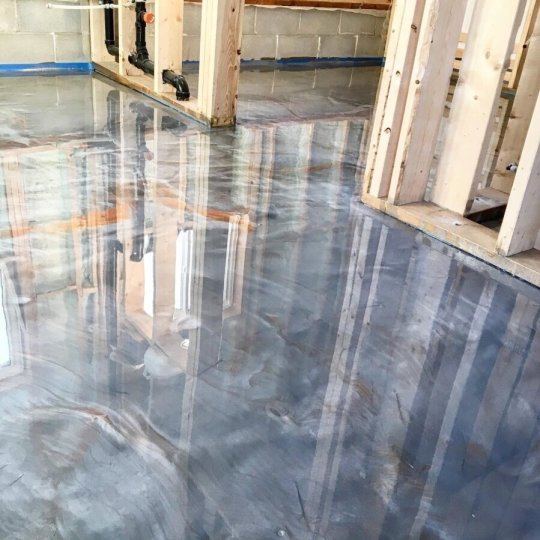
https://mtcustomconcrete.com/epoxy/
2 notes
·
View notes
Text
Concrete Blocks - Manufacturing, Classification & Uses
Concrete blocks are nowadays replacing bricks in masonry construction, notably in many multi-storeyed buildings. They are available in three types namely solid, hollow and cellular, widely used for the construction of filler walls and boundary walls in RC framework.
Concrete blocks are usually made in large sizes to make blockwork faster and consume less cement in joints than the brickwork. If the percentage of the voids is more than 25%, then they are hollow blocks and blocks with voids less than 25% are only perforated blocks.
The cellular concrete blocks are generally referred to as lightweight aerated concrete blocks. All these blocks are extensively used for compound walls and non-loadbearing walls.
Hollow blocks are specially made for loadbearing walls, which are useful in reducing a dead load of masonry in buildings. Blocks can also be with cement and sand called cement-sand blocks or with cement and soil called soil-cement blocks which are of low strength and use for low-cost construction.
Manufacturing of Concrete Blocks
BIS recommends a fineness modulus of the combined aggregate between 3.6 to 4 and coarse aggregates used are of size 6 to 12 mm. Lean mixes up to 1:8 are generally used. Concrete mix for concrete blocks should not be richer than one part of the cement to six parts of the volume of combined aggregate.
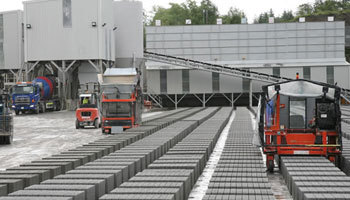
Concrete blocks can be handmade and also machine-made. The cast block is then cured in a water tank or yard for at least 14 days (water need to be changed at least every 4 days).
After curing, the blocks are dried for 4 weeks before being used in masonry construction. They should be stacked with voids in the horizontal direction to facilitate easy drying, or they should be steam cured and dried.
The whole process allows the complete shrinkage of the block to take place they are laid on the wall, which is very important for strong walls.
Classification of Concrete Blocks
Hollow concrete blocks
Open and Closed cavity-type hollow concrete blocks are classified into three grades:
Grade A - They possess a minimum density of 1500 kg/m³ and are used for load-bearing walls.
Grade B - They have a density below 1500 kg/m¬³ and used for load-bearing walls.
Grade C - These blocks are used for non-load bearing walls and have density more than 1000 kg/m³.
All these blocks are available in decorative facings like fluted facing to provide artistic effects.
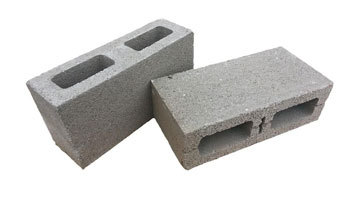
Solid concrete blocks
They should be manufactured for specific concrete strength of 4.0 and 5.0 N/mm² in 28 days. These blocks are used as load-bearing walls and have a density of not less than 1800 kg/m³.
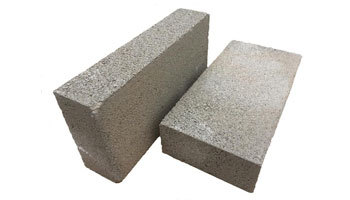
Paver blocks
These blocks are solid concrete blocks of different shapes specially made for exterior ground paving on sidewalks, parking lots, driveways, petrol pumps, industrial floors, etc.
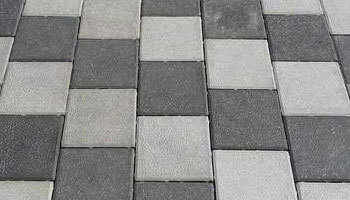
AAC Blocks
AAC blocks refer as Autoclaved Aerated Concrete Blocks. These blocks are also termed as light-weight hollow blocks.
They are prepared as solid blocks from cement, water and materials like ground sand, pulverized fly ash together with additives to aerate and stabilize the air bubbles.
The final result is a mixture of thick liquid which is then poured into steel moulds to form large cakes. After some time, the mixture sets and ready to cut into a serious of individual blocks of required size using taut steel wires.

Very light blocks for partition and moderate-weight blocks for light loadbearing walls can be obtained from aac blocks. These blocks do not shrink on drying as the material is obtained by autoclaving.
The autoclaved cement product is crystalline, which is different from the product obtained by normal wet curing or by ordinary steam curing.
Sizes and Tolerances
The nominal dimensions of concrete block as per BIS are as follows:
Length - 600, 500, 450 or 400 mm
Height - 100 or 200 mm
Width - 50, 75, 100, 150, 200, 250 or 300 mm
Actual sizes will be less than 10 mm of mortar thickness. For Concrete and Hollow concrete blocks nominal length 390 mm and height 190 mm. The thickness for loadbearing walls is 190 mm, compound walls 140 mm and for filler walls 90 mm.
These dimensions can easily be achieved in machine-made blocks than handmade blocks. The width of blocks use for load-bearing walls is 200 mm and for parapet or filler walls is 100 mm.
Points to Remember:
The mortar strength should not be more than the strength of the blocks. With high mortar strength, cracks will be less and very large, but with low mortar strength, cracks will be small and distributed.
We should use only blocks that are cured properly for at least 14 days and dried for 4 weeks to avoid shrinkage during construction.
We should not wet the blocks while placing in masonry construction.

Freshly-made and uncured concrete blocks should never be allowed on the work.
Blockwork, particularly ordinary cement sand blocks and soil-cement blocks should not be used as loadbearing walls for concrete slab roof which favours to expand and contract with temperature.
The maximum difference in sizes allowed is ±5 mm in length and ±3 mm in height and width.
They should be protected from rains while being stored as they absorb moisture by wetting and shrinking on drying.
The main disadvantage of concrete blocks is shrinkage due to the movement of moisture content which is not present in bricks. As these blocks are much larger than bricks, any foundation movement will cause blockwork to crack more than the brickwork.
Cement blocks, Concrete blocks, Hollow concrete blocks, solid concrete blocks, Paver blocks, AAC blocks Concrete blocks in Hyderabad
#aac Blocks#aac blocks online#aac block size#Cement blocks#Concrete blocks#Hollow concrete blocks#solid concrete blocks#Paver blocks#AAC blocks
2 notes
·
View notes
Text
Hemp: A Sustainable Solution for a Greener Planet
World Environment Day 5th June

Climate change and environmental degradation have become pressing global concerns, prompting the search for sustainable alternatives to traditional materials and practices. One such alternative is hemp, a versatile plant with numerous applications in various industries. This article explores the environmental benefits of hemp cultivation and its potential to contribute to a cleaner, healthier, and more sustainable planet.
Hemp's Environmental Benefits
1. Carbon Sequestration
Hemp plants are highly effective at absorbing carbon dioxide (CO2) from the atmosphere, helping to combat climate change. Studies have shown that a single acre of hemp cultivation can absorb as much as 4.1 metric tons of CO2 per year. This remarkable ability to sequester carbon makes hemp an essential ally in the fight against global warming.
2. Water Conservation
Hemp requires significantly less water than other crops, such as cotton, using about 50% less water during cultivation. This makes hemp an ideal choice for sustainable agriculture, particularly in regions facing water scarcity.
3. Natural Pest Resistance
Hemp is naturally resistant to pests and diseases, reducing the need for harmful pesticides. By replacing pesticide-dependent crops like cotton with hemp, we can significantly decrease the environmental impact of agricultural activities and reduce greenhouse gas emissions.
4. Renewable Energy Source
Hemp seeds can be used to produce biodiesel, a sustainable alternative to fossil fuels. Hemp-based biofuels have the potential to reduce our reliance on non-renewable energy sources and decrease our carbon footprint. Moreover, hemp can be grown in poor soil conditions and requires little land, making it an efficient and eco-friendly option for biofuel production.
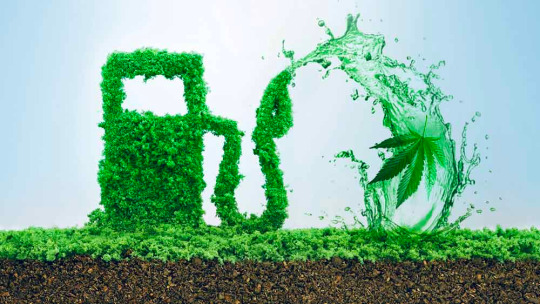
5. Sustainable Building Materials
Hemp can be used to create environmentally friendly building materials, such as hempcrete, which is a mixture of hemp fibres and lime. Hempcrete has excellent insulation properties, is mould-resistant, and has a lower carbon footprint than traditional building materials like concrete and steel. By incorporating hemp-based materials into construction, we can reduce emissions and toxic chemicals released into the environment.
6. Eco-friendly Textiles
Hemp fibres can be used to produce sustainable textiles that are biodegradable and require fewer resources during production. Hemp fabric is a more environmentally friendly alternative to cotton, as it has lower carbon emissions and captures more CO2 from the atmosphere.

7. Paper Production
Hemp can also be used to produce paper, offering a sustainable alternative to wood-based paper products. Hemp paper requires less water and chemicals during production and is more recyclable than wood paper. By replacing wood with hemp in paper manufacturing, we can slow down deforestation and reduce the environmental impact of the paper industry.
8. Biodegradable Plastics
Hemp-based plastics are biodegradable and have a shorter degradation time compared to conventional plastics. By replacing petroleum-based plastics with hemp alternatives, we can reduce plastic pollution and its harmful effects on the environment.
Conclusion
Hemp offers a multitude of environmental benefits, making it a promising solution for a greener and more sustainable future. Its ability to sequester carbon, conserve water, resist pests, and provide renewable energy sources, along with its applications in eco-friendly building materials, textiles, paper production, and biodegradable plastics, demonstrates its potential to revolutionise various industries and contribute to a cleaner planet.
As the world continues to grapple with climate change and environmental degradation, embracing sustainable practices and materials like hemp is crucial. With proper cultivation, harvesting, and extraction methods, hemp and its related compounds have the potential to significantly impact our efforts to combat climate change and promote a more sustainable future for generations to come.
2 notes
·
View notes
Text
Concrete batching plant manufacturer | KI Conequip Pvt ltd.
Manufacturing concrete batching plants is a very important process in the construction industry. A concrete batching plant produces small batches of concrete which are then used to build roads, bridges and other structures. Contact KI Conequip for the best concrete batching plant manufacturer.
| Visit us at : http://www.kiconequip.com
| Phone : +91 8980021901
| Email : [email protected]
#concrete batching plant#concrete batching plants#concrete batching plant manufacturer#concrete batching plant manufacturers#batching plant manufacturer#batching plant manufacturers in india#concrete mixture mixing plant#concrete batch mixing plant
0 notes
Photo

@brutbuilds
DOLOSSE
A dolos is an imposing concrete block in a complex geometric shape, with a variety of uses including protecting harbour walls from the erosion caused by ocean waves. In the eighties, numerous dolosse were installed in the island regions, such as the Magdalen Islands, as part of a widespread sea port protection program.
Each dolos is a fully cast piece, with impeccable finishing standards. Self-levelling concrete is used, providing the structures with a good finish. The concrete mixture must ensure great compressive strength, considering removal from the mould and handling the dolosse are exposed to during the manufacturing process.
3 notes
·
View notes
Text
Ready Mix Concrete: The Key to Karachi’s Modern Architectural Success
Karachi, Pakistan's bustling metropolitan city, has experienced exponential growth over the past few decades. With a rapidly expanding population and increasing urbanization, the demand for innovative construction materials has reached unprecedented levels. Among these, Ready Mix Concrete in Karachi has emerged as a cornerstone of modern architecture and infrastructure development.

The Rise of Ready Mix Concrete in Karachi
Ready-mix concrete, a pre-prepared mixture of cement, water, sand, and aggregates, is produced in controlled environments and delivered to construction sites. This eliminates the need for on-site mixing, enhancing efficiency and consistency. Karachi, with its high-paced construction industry, has seen a sharp rise in the adoption of this material due to its convenience and quality.
The use of ready-mix concrete in Karachi spans residential buildings, commercial complexes, roads, bridges, and even skyscrapers. Its role in enabling faster project execution without compromising quality has made it a favored choice among contractors and architects.
Advantages of Ready Mix Concrete in Karachi
1. Precision and Quality Control
Unlike traditional methods of mixing concrete on-site, ready-mix concrete is manufactured under strict quality controls. This ensures that each batch meets the desired strength and consistency, a critical factor in Karachi's demanding construction environment.
2. Time Efficiency
In a city where time is money, ready-mix concrete significantly reduces delays associated with on-site mixing. Pre-mixed concrete is delivered directly to the site, allowing construction activities to proceed without interruptions.
3. Cost Savings
While the initial cost of ready-mix concrete might seem higher, its long-term benefits outweigh the investment. Reduced labor, material wastage, and faster project timelines contribute to substantial savings.
4. Environmental Benefits
With growing awareness about sustainability, ready-mix concrete offers an eco-friendly alternative. Controlled production minimizes wastage, and the use of supplementary materials, such as fly ash, further reduces the carbon footprint.
5. Versatility
Ready-mix concrete is highly versatile, catering to various construction needs. Whether it’s for the foundation of a residential building or the intricate details of a commercial complex, this material can be customized to meet specific requirements.
Applications of Ready Mix Concrete in Karachi
The adaptability of ready-mix concrete has made it an integral part of Karachi’s construction industry. Its applications include:
Residential Construction: From small houses to large housing societies, ready-mix concrete ensures durability and quality in residential projects.
Commercial Complexes: Skyscrapers, shopping malls, and office buildings rely on ready-mix concrete for structural integrity.
Infrastructure Projects: Roads, bridges, and flyovers in Karachi use ready-mix concrete for long-lasting performance under heavy traffic.
Industrial Construction: Factories, warehouses, and storage units benefit from the high strength and quick setting of ready-mix concrete.Why Karachi Needs Ready Mix Concrete
Urban Expansion
As Karachi grows, so does the need for robust infrastructure and modern architecture. Ready-mix concrete provides the foundation for sustainable and resilient construction.
Weather Resilience
Karachi’s climate, with its high temperatures and humidity, demands construction materials that can withstand harsh weather conditions. Ready-mix concrete offers durability and resistance, making it ideal for the city’s unique challenges.
Meeting Deadlines
The fast-paced construction industry in Karachi often works under tight deadlines. The quick delivery and easy application of ready-mix concrete help projects stay on schedule.
How to Choose the Best Ready Mix Concrete in Karachi
Selecting the right supplier is critical to the success of any construction project. Here are a few tips for finding reliable ready-mix concrete in Karachi:
Reputation: Look for suppliers with a strong track record of delivering quality materials.
Customization: Ensure the supplier can provide mixes tailored to your project’s specific needs.
Timely Delivery: A reliable supplier will deliver on time to avoid project delays.
Certifications: Verify that the supplier follows industry standards for production and quality.
Customer Support: Choose a supplier who offers excellent after-sales service and support.
The Role of Allied Materials in Karachi’s Construction Industry
Allied Materials has emerged as a trusted name for Ready Mix Concrete in Karachi. With state-of-the-art production facilities and a commitment to quality, Allied Materials ensures that every batch of concrete meets the highest standards.
Why Allied Materials Stands Out
Advanced Technology: Modern equipment and techniques ensure precision in production.
Customized Solutions: Allied Materials offers tailored mixes to suit diverse project needs.
Timely Delivery: Efficient logistics ensure that materials are delivered on time, every time.
Customer Satisfaction: A focus on client needs and feedback ensures exceptional service.
Time-Saving Tips for Using Ready Mix Concrete
Prepare the Site: Ensure the site is ready for concrete pouring to avoid delays.
Use the Right Equipment: Leverage tools like concrete pumps for efficient placement.
Plan Deliveries: Schedule deliveries according to your project timeline for seamless workflow.
Train Workers: Equip your team with the knowledge to handle ready-mix concrete effectively.
Challenges in Using Ready Mix Concrete and How to Overcome Them
While ready-mix concrete offers numerous benefits, some challenges can arise. Here’s how to address them:
Delayed Deliveries: Partner with a reliable supplier to ensure timely delivery.
Site Access: Prepare the site in advance and ensure accessibility for delivery trucks.
Material Wastage: Proper planning and trained workers can minimize wastage.
Curing Issues: Monitor weather conditions and follow best practices for curing concrete.
Future of Ready Mix Concrete in Karachi
The adoption of ready-mix concrete is set to grow as Karachi continues to expand. Innovations like self-healing concrete, eco-friendly additives, and digital tracking systems will further enhance its utility and sustainability. Builders and developers can look forward to faster, greener, and more cost-effective construction methods in the years to come.
Conclusion
Ready-mix concrete has revolutionized Karachi’s construction industry, offering unparalleled efficiency, quality, and sustainability. Its role in shaping the city’s skyline and infrastructure is undeniable. By partnering with trusted suppliers like Allied Materials, builders can ensure successful project outcomes while saving time and resources. For high-quality Ready Mix Concrete in Karachi, trust Allied Materials to meet all your construction needs. Experience the difference that innovative materials can make in bringing your architectural vision to life.
0 notes
Text
GFS Tanks as Biogas Anaerobic Digester Tanks for Sewage Water Disposal: A Sustainable Solution for Wastewater Treatment
At Shijiazhuang Zhengzhong Technology Co., Ltd. (Center Enamel), we are proud to offer our high-quality Glass-Fused-to-Steel (GFS) tanks as the ideal solution for biogas anaerobic digesters in sewage water disposal and wastewater treatment projects. With over 30 years of experience in tank design and manufacturing, we provide sustainable, efficient, and durable storage solutions that support wastewater treatment processes, turning organic waste into valuable biogas while ensuring environmental sustainability.

The Role of Anaerobic Digestion in Sewage Water Treatment
Anaerobic digestion is a highly effective and environmentally friendly process for treating sewage water and other organic waste materials. It involves the breakdown of organic matter by microorganisms in an oxygen-free environment, producing biogas (a mixture of methane and carbon dioxide) that can be used as a renewable energy source. This process plays a critical role in municipal sewage treatment and industrial wastewater management, reducing environmental pollutants while generating sustainable energy.
A key component of the anaerobic digestion process is the biogas anaerobic digester tank, where the organic matter is stored and digested by the microorganisms. The efficiency of this system largely depends on the quality of the digester tank, which needs to be durable, leak-proof, and resistant to the challenging conditions associated with wastewater treatment.
As a leading storage tank manufacturer in China. At Shijiazhuang Zhengzhong Technology Co., Ltd., we excel in providing high-quality bolted steel tanks tailored for the diverse needs of fish farming. Our extensive range of bolted steel tanks includes Glass-Fused-to-Steel (GFS) tanks, fusion bonded epoxy tanks, stainless steel tanks, and galvanized steel tanks, each designed to offer exceptional durability, efficiency, and adaptability for aquaculture applications.
Configuration of Customized Storage Tanks
Storage tanks
Volume
Roofs
Application
Design Requirements
GFS Tanks
SS Tanks
Fusion Bonded Epoxy Tanks
Galvanized Steel Tanks
Welded Steel Tanks
<1000m³
1000-10000m³
10000-20000m³
20000-25000m³
>25000m³
ADR Roof
GFS Roof
Membrane Roof
FRP Roof
Trough Deck Roof
Wastewater Treatment Project
Drinking Water Project
Municipal Sewage Project
Biogas Project
Fire Water Storage Project
Oil Storage Project
Water Supply & Drainage System
Seismic Design
Wind Resistant Design
Lightning Protection Design
Tank Insulation Design
WasteWater Treatment Project Equipment Supply
Pretreatment Equipment
Resource Utilization System
Sludge Treatment System
Other Equipment
Mechanical Bar Screen
Solid-liquid Separator
Submersible Mixer
Gas Holder
Boiler System
Boost Fan
Biogas Generator
Torch System
Dehydration and Desulfurization Tank
PAM Integration Dosing Device
Screw Sludge Dewatering Machine
Slurry Separation Centrifuge
Sewage Pump
Mud Scraper
Submersible Sewage Pump
Three-phases Separator
Why Choose Glass-Fused-to-Steel Tanks for Anaerobic Digesters?
1. Superior Durability and Corrosion Resistance
The Glass-Fused-to-Steel coating technology used in our tanks offers an exceptional level of corrosion resistance, making them ideal for the harsh environment inside anaerobic digesters. The chemical and biological processes involved in anaerobic digestion can be aggressive, with exposure to acidic or alkali by-products. Our tanks’ unique glass coating provides long-term protection against corrosion, ensuring a longer lifespan and lower maintenance costs compared to traditional materials like concrete or carbon steel.
2. High Temperature and Pressure Resistance
Anaerobic digestion is typically carried out at elevated temperatures, and biogas production can generate internal pressure. Glass-Fused-to-Steel tanks are engineered to withstand these conditions, maintaining their structural integrity even under high temperature and pressure. This makes them particularly suitable for sewage water treatment plants that require continuous, reliable operation without the risk of failure or leaks.
3. Leak-Proof and Secure
Our GFS tanks provide an incredibly smooth, non-porous surface that is not only resistant to corrosion but also prevents leaks. This is crucial in anaerobic digestion processes, where biogas, slurry, and wastewater need to be contained securely to prevent environmental contamination and ensure the efficiency of the biogas production process.
4. Modular Design for Flexibility and Adaptability
The modular design of Center Enamel’s Glass-Fused-to-Steel tanks makes them a highly adaptable solution for a wide range of wastewater treatment projects. These tanks can be easily customized to meet specific project needs, including size and capacity. Whether it's a small municipal treatment facility or a large industrial wastewater plant, GFS tanks can be tailored to suit the scale and demands of your project.
5. Odor Control and Environmental Safety
Anaerobic digestion can produce unpleasant odors as organic matter breaks down. Our GFS tanks are designed to help control odors effectively, ensuring that your sewage treatment process operates in a safe, environmentally friendly manner. The durable glass coating and tight seal prevent harmful gases from escaping into the atmosphere, while also protecting the surrounding environment from contamination.
Environmental and Economic Benefits of GFS Tanks for Sewage Water Disposal
Sustainability and Renewable Energy Production
By integrating biogas anaerobic digesters in sewage treatment systems, municipalities and industries can not only treat wastewater efficiently but also contribute to renewable energy production. The biogas generated during anaerobic digestion can be used for power generation, heating, or even as a substitute for natural gas, reducing dependency on fossil fuels and lowering carbon emissions.
Cost-Effectiveness and Low Maintenance
Center Enamel’s GFS tanks offer a cost-effective solution for wastewater treatment. Thanks to their low maintenance needs, extended lifespan, and resistance to corrosion, our tanks significantly reduce long-term operational costs. Their modular design allows for easy expansion or modification, ensuring that your anaerobic digestion system can grow in tandem with your project’s needs.
Global Success in Wastewater Treatment Projects
With more than 30 years of expertise in the storage tank industry, Center Enamel has earned a reputation as a trusted partner for biogas anaerobic digestion projects globally. Our Glass-Fused-to-Steel tanks have been successfully deployed in numerous municipal sewage treatment plants, industrial wastewater management systems, and bioenergy facilities worldwide.
Our international projects include successful installations across more than 100 countries, including the USA, Australia, Canada, Malaysia, Indonesia, Brazil, and South Africa, where our tanks have helped improve the efficiency and sustainability of wastewater treatment processes.
Contact Center Enamel for Your Biogas Anaerobic Digester Project
If you are planning to integrate anaerobic digestion into your sewage water disposal or wastewater treatment facility, consider Center Enamel as your trusted partner. Our Glass-Fused-to-Steel tanks offer the durability, flexibility, and environmental benefits that are essential for the success of your biogas production and wastewater management systems.
Contact us today to learn more about how our GFS tanks can contribute to your anaerobic digestion project and help you achieve more efficient, sustainable sewage treatment. Let us help you convert waste into renewable energy while protecting the environment and improving the quality of wastewater management worldwide.
0 notes
Text
Exploring the Versatility of Quartz Powder in Industry
Quartz powder, derived from the natural mineral quartz, has emerged as a cornerstone material across various industries. With its unique physical and chemical properties, it has become indispensable in applications ranging from construction to electronics. Quartz Powder Manufacturers around the globe are striving to meet the increasing demand for this versatile material, ensuring that industries continue to thrive with high-quality quartz powder.

Understanding Quartz Powder
Quartz is a silica-rich mineral that undergoes processing to produce fine quartz powder. The end product is known for its high purity, excellent hardness, and resistance to chemical reactions. These qualities make quartz powder a preferred choice in sectors such as:
Construction: Used in cement and concrete mixtures for improved durability and aesthetic appeal.
Electronics: Essential for producing semiconductors, solar panels, and optical devices due to its insulating properties.
Glass Manufacturing: Serves as a key raw material in the production of glass, contributing to its clarity and strength.
Paints and Coatings: Acts as a filler to enhance weather resistance and texture.
Ceramics: Adds strength and smoothness to ceramic tiles and sanitary ware.
With such diverse applications, the demand for quartz powder continues to soar, urging manufacturers to innovate and deliver products that meet industry standards.
Qualities of High-Grade Quartz Powder
For quartz powder manufacturers, quality is paramount. High-grade quartz powder possesses:
Purity: Contains minimal impurities, especially in silicon dioxide (SiO₂) content.
Granular Consistency: Fine, uniform particles that ensure seamless application.
Thermal Stability: Withstands high temperatures, making it ideal for industrial processes.
Chemical Resistance: Non-reactive to most chemicals, ensuring long-lasting performance.
Manufacturing Process of Quartz Powder
Quartz powder production involves a multi-step process:
Mining and Extraction: Raw quartz is mined from quarries and transported for processing.
Crushing and Grinding: Quartz is crushed into smaller pieces and ground to the desired powder consistency.
Screening and Sorting: Advanced machinery ensures that the powder meets specific size requirements.
Purification: Techniques such as magnetic separation and acid washing remove impurities to achieve high purity.
Packaging and Distribution: The final product is packed in moisture-resistant bags and transported to clients.
The process is energy-intensive and requires precision to maintain consistent quality.
The Role of Quartz Powder in Modern Industries
The adaptability of quartz powder has positioned it as a vital resource in modern industrial applications. For instance:
In the solar energy sector, quartz powder is used to manufacture photovoltaic cells, driving sustainable energy solutions.
In oil and gas exploration, it plays a crucial role in hydraulic fracturing, improving extraction efficiency.
Pharmaceutical and cosmetic industries utilize its non-toxic nature for formulating products that are safe and effective.
Such wide-ranging uses underline its importance in both traditional and emerging markets.
India’s Growing Market for Quartz Powder
India has emerged as a significant player in the global quartz powder market. With abundant natural resources and advanced manufacturing capabilities, the country has positioned itself as a hub for high-quality quartz powder. Indian manufacturers focus on:
Export Excellence: Supplying premium quartz powder to countries across Asia, Europe, and the Americas.
Sustainability: Implementing eco-friendly practices in mining and processing.
Customization: Catering to specific client needs by offering tailored grades of quartz powder.
One such prominent name in the Indian quartz powder manufacturing landscape is the Sudarshan Group. Known for its commitment to quality and innovation, the company has set benchmarks in delivering quartz powder that meets global standards.
Choosing the Right Quartz Powder Manufacturer
For businesses reliant on quartz powder, selecting the right manufacturer is crucial. Here are key factors to consider:
Reputation: Look for manufacturers with a proven track record of quality and reliability.
Certifications: Ensure compliance with industry certifications and environmental standards.
Supply Chain Efficiency: A robust logistics network ensures timely delivery of products.
Customer Support: Responsive service for addressing client requirements and concerns.
Conclusion
Quartz powder manufacturers are the backbone of industries that depend on this versatile material. With advancements in technology and increasing global demand, the future of quartz powder manufacturing is bright. Companies like the Sudarshan Group exemplify the industry's potential by consistently delivering quality products tailored to diverse needs.
By choosing the right quartz powder manufacturer, businesses can ensure the success of their projects while contributing to sustainable industrial growth. As quartz powder continues to shape industries, its significance in the global economy will only expand further.
0 notes
Text
The Role of Cannabis in Sustainable Agriculture: Investigating How Hemp Cultivation Contributes to Environmental Conservation and Economic Growth
Hemp, a non-psychoactive variety of the Cannabis sativa plant, has emerged as a versatile crop with significant environmental and economic benefits. Its cultivation addresses key challenges in sustainability, from reducing carbon emissions to supporting rural economies.
Environmental Conservation
Hemp cultivation offers numerous ecological advantages: Carbon Sequestration Hemp absorbs more carbon dioxide (CO₂) per hectare than most crops, acting as an effective carbon sink. The entire plant can be utilized, minimizing waste and maximizing carbon storage.
Soil Health and Regeneration Phytoremediation: Hemp cleans soil by absorbing heavy metals and toxins, making it ideal for rehabilitating contaminated lands. Soil Structure: Its deep roots aerate the soil, reducing erosion and improving water retention.
Pesticide and Herbicide Reduction Hemp is naturally resistant to many pests and weeds, reducing the need for chemical pesticides and herbicides. Lower chemical use protects local ecosystems and reduces agricultural runoff.
Biodiversity Support Hemp fields can provide habitats for pollinators and other beneficial species.
Sustainable Applications of Hemp
Hemp can be processed into a wide array of eco-friendly products, reducing reliance on fossil fuels and non-renewable resources: Biodegradable Plastics Hemp fibers can replace petroleum-based plastics, contributing to reduced plastic pollution.
Construction Materials Hempcrete, a mixture of hemp hurds and lime, is a sustainable alternative to concrete. It is carbon-negative, insulating, and durable.
Textiles and Paper Hemp textiles and paper require less water and fewer chemicals compared to cotton and wood pulp industries. Hemp paper can be recycled more times than traditional wood-based paper.
Biofuels Hemp seeds and stalks can be used to produce bioethanol and biodiesel, offering a renewable energy source.
Economic Growth
Hemp cultivation has the potential to drive economic development in both urban and rural settings: Job Creation Hemp farming and processing create jobs across agriculture, manufacturing, and retail sectors. Industries such as textiles, construction, and cosmetics are increasingly incorporating hemp products.
Support for Rural Economies Hemp is a fast-growing crop that thrives in diverse climates, offering farmers an additional source of income. As demand for hemp-based products rises, rural communities can benefit from expanded markets.
Versatility and Profitability Hemp can produce multiple products from a single crop, maximizing returns for farmers. Demand for organic and sustainable products ensures long-term market viability.
Challenges in Hemp Cultivation
Despite its benefits, hemp cultivation faces some obstacles: Regulatory Hurdles Legal restrictions on cannabis can limit hemp farming and processing, even for non-psychoactive varieties.
Knowledge Gaps Many farmers lack access to information and resources for effective hemp cultivation.
Infrastructure and Processing Limited infrastructure for processing hemp products can hinder large-scale adoption.
The Future of Hemp in Sustainable Agriculture
Efforts to integrate hemp into modern agriculture are gaining momentum: Policy Support: Governments worldwide are revising laws to encourage hemp farming. Research and Innovation: Investment in hemp-based technologies, such as advanced processing techniques and product development, is expanding its applications. Consumer Demand: Increasing awareness of sustainability is driving demand for hemp-based goods.
Conclusion Hemp cultivation embodies the principles of sustainable agriculture, offering solutions to environmental challenges while fostering economic growth. With supportive policies, innovation, and public awareness, hemp could play a pivotal role in creating a more sustainable and resilient agricultural system.
0 notes
Text
Vinplast-245: A Breakthrough for Concrete Admixture Manufacturers
In modern construction, chemical admixtures have become indispensable for enhancing concrete properties, improving performance, and addressing diverse construction challenges. These additives enable the production of high-quality concrete suitable for a variety of applications. While not a direct concrete admixture, Vinplast-245, an acrylic superplasticizer developed by Vinati Organics, provides significant advantages to concrete admixture manufacturers. By integrating this innovative product into their formulations, manufacturers can achieve superior workability, durability, and water reduction without compromising quality. This comprehensive guide delves into the key applications, benefits, and technical aspects of Vinplast-245, showcasing its pivotal role in advancing the construction industry.
The Role of Chemical Admixtures in Modern Construction
Chemical admixtures are speciality products added to concrete during mixing to improve its properties. These include enhancements in strength, durability, setting time, and workability, making chemical admixtures crucial for complex construction projects. Admixtures like superplasticizers and air-entraining agents are widely used to optimize concrete formulations.
While Vinplast-245 is not directly used as a concrete admixture, it provides immense value to construction chemical manufacturers by improving the effectiveness of their admixture formulations. This versatility underlines its importance in the construction sector, where achieving the perfect balance of performance and cost-efficiency is critical.
Key Features and Applications of Vinplast-245
Enhancing Workability Without Additional Water
Vinplast-245 enables the creation of concrete with high workability without increasing the water-to-cement (W/C) ratio. This property is essential for producing cohesive and pumpable concrete mixtures, particularly in large-scale projects where ease of placement and long-term performance are critical.
Ideal for High-Temperature Conditions
In regions with extreme temperatures, maintaining the stability and performance of chemical admixtures is a significant challenge. Vinplast-245 is designed to perform consistently in high-temperature environments, ensuring reliable results even when transported over long distances.
Improving Slump Retention
One of the standout features of Vinplast-245 is its ability to retain the slump of concrete mixtures. By enabling controlled retardation of setting time, this superplasticizer ensures that concrete remains workable for extended periods—ideal for projects with complex or prolonged construction schedules.
Simplified Placement with Fluidity
Vinplast-245 imparts extreme fluidity to concrete mixtures, facilitating rapid placement during construction. This feature enhances productivity and reduces labour costs, contributing to streamlined workflows on construction sites.
Advantages of Vinplast-245 for Concrete Admixture Manufacturers
Economical Alternative to Conventional Additives
Vinplast-245 serves as a cost-effective substitute for traditional water-reducing agents. Its advanced formulation allows manufacturers to achieve superior concrete properties at a fraction of the cost, making it an approved choice for budget-conscious projects.
Enabling High-Strength Concrete
As a superplasticizer, Vinplast-245 significantly reduces the water content required for mixing, resulting in the production of high-strength concrete. This property is crucial for applications such as high-rise buildings and heavy infrastructure projects, where structural integrity is paramount.
Consistent Performance in Various Conditions
Whether used in extreme temperatures or under challenging transportation conditions, Vinplast-245 maintains its performance. Its compatibility with diverse admixture formulations ensures consistent results across a range of applications.
Controlled and Predictable Setting Times
Vinplast-245 offers precise control over setting times, allowing manufacturers to customize their formulations to meet specific project requirements. This predictability is essential for ensuring the timely completion of construction schedules.
Improved Sustainability
By reducing the need for excess water and enhancing the durability of concrete, Vinplast-245 supports sustainable construction practices. It enables manufacturers to produce environmentally friendly concrete mixtures, aligning with the global push for greener building solutions.
Technical Guidelines for Using Vinplast-245
Dosage Recommendations
The recommended dosage of Vinplast-245 ranges from 0.3 to 0.5 kg per 100 kg of cement, depending on the desired concrete properties and project requirements.
Mixing Instructions
Vinplast-245 should be added directly to the mixing water before blending with wet aggregates.
This ensures optimal dispersion of the superplasticizer, leading to more consistent and high-quality concrete production.
Packaging and Storage
Vinplast-245 is available in 240 kg HDPE drums, with custom packaging options available to meet specific customer needs. Proper storage in a cool, dry place ensures the longevity and effectiveness of the product.
Applications in the Construction Industry
Vinplast-245 is a versatile product that caters to a wide range of construction needs. Below are some key areas where its benefits are most evident:
Residential and Commercial Buildings
In housing and commercial projects, where high-strength concrete with excellent workability is required, Vinplast-245 plays a critical role in ensuring durable and aesthetic results.
Infrastructure Projects
Large-scale infrastructure projects such as highways, bridges, and dams demand concrete with superior strength and durability. Vinplast-245 enables manufacturers to meet these stringent requirements while maintaining cost efficiency.
Precast Concrete Production
For precast applications, where rapid placement and setting are essential, Vinplast-245 provides the fluidity and workability needed to produce high-quality precast elements.
High-Temperature Applications
In regions with extreme weather conditions, Vinplast-245 ensures consistent performance, making it a reliable choice for projects in challenging environments.
Why Choose Vinati Organics for Vinplast-245?
Industry Leadership
Vinati Organics is a leading name in the speciality chemicals industry, recognized for its innovation and commitment to quality. The company’s expertise ensures that Vinplast-245 meets the highest industry standards.
Commitment to Sustainability
By developing environmentally friendly products like Vinplast-245, Vinati Organics supports the global shift toward sustainable construction practices.
Tailored Solutions
With customizable packaging options and technical support, Vinati Organics caters to the specific needs of its clients, ensuring a seamless customer experience.
In today’s competitive construction industry, Vinplast-245 stands out as a game-changing product for concrete admixture manufacturers. Its ability to enhance workability, reduce water content, and improve overall concrete performance makes it an essential component for modern construction practices. By choosing Vinplast-245, manufacturers can produce high-quality, cost-effective concrete formulations that meet the evolving demands of the industry.
To learn more about how Vinplast-245 can transform your concrete admixture formulations, visit the product page or contact Vinati Organics today.
0 notes
Text
Marble Epoxy Floors: Luxury Underfoot Without the Hassle
Introduction
When it comes to flooring options, homeowners often find themselves torn between aesthetics and practicality. Enter marble epoxy floors, a stunning solution that marries elegance with functionality. In this comprehensive guide, we will delve into the world of marble epoxy floors, exploring their Artcrete Designs benefits, installation processes, maintenance tips, and everything in between. Whether you're considering them for best Artcrete designs in Austin TX your home or a commercial space, you'll soon discover why these luxurious floors are stealing the spotlight.
What Are Marble Epoxy Floors?
Marble epoxy floors are a unique combination of traditional marble aesthetics with the durability and versatility of epoxy resin. This fusion allows homeowners to enjoy the sophisticated look of marble without the associated maintenance hassles.
The Composition of Marble Epoxy Floors Epoxy Resin: A synthetic compound that hardens when mixed with a hardener, creating a durable surface. Marble Chips: Real or faux marble chips can be incorporated into the epoxy mixture for an authentic appearance. Why Choose Marble Epoxy Floors? Aesthetic Appeal: The high-gloss finish mimics natural marble. Durability: Resistant to stains, scratches, and moisture. Ease of Maintenance: Cleaning is straightforward compared to traditional marble. Benefits of Choosing Marble Epoxy Floors 1. Stunning Visuals
One of the most significant attractions of marble epoxy floors is their visual appeal. With a variety of colors and patterns available—including metallic finishes or glitter flakes—homeowners can customize their flooring to fit any design vision.
2. Cost-Effective Luxury
While traditional marble might break the bank, marble epoxy offers an affordable alternative that provides similar luxury without compromising quality.
3. Versatility Across Spaces
From residential homes to commercial spaces such as offices and retail stores, marble epoxy floors can adapt beautifully to various environments.
4. Eco-Friendly Options Available
Many manufacturers offer eco-friendly epoxy formulations that are low in volatile organic compounds (VOCs), making them safer for indoor air quality.
How Are Marble Epoxy Floors Installed?
Installing marble epoxy floors may seem daunting, but with the right guidance and preparation, it can be a seamless process.
Step-by-Step Installation Process 1. Prepare the Substrate
Ensure that your concrete floor is clean and free from debris or moisture before beginning installation.
2. Apply Primer
A primer helps ensure better adhesion between the floor and epoxy coating.
3. Mix Your Epoxy
Combine your chosen resin with hardener according to manufacturer instructions for optimal results.
4. Add Marble Chips
Incorporate real or synthetic marble chips into your mix to achieve your desired look.
5. Pour & Spread
Using a trowel or squeegee, evenly distribute the mixture across your flooring surface.
0 notes